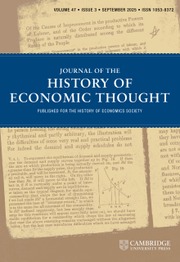Article contents
Fifty Years after Samuelson's “The Pure Theory of Public Expenditure”: What are we Left With?
Published online by Cambridge University Press: 11 June 2009
Extract
In 1954, Paul A. Samuelson presented on just two and a half pages what he claimed to be “a pure theory of government expenditure on collective consumption goods” (1954c, p. 388). Just a year later, he supplemented this theory by an equivalent diagrammatic formulation and a few clarifying comments (Samuelson 1955). Although his initial paper was strongly criticized on various grounds, an industry was launched and public goods—or, as referred to initially by Samuelson, collective consumption goods—now play a crucial role in a number of theories like fiscal competition or endogenous growth, and in almost all textbooks on public economics or microeconomics at least a paragraph is devoted to public goods. In fact, Samuelson's 1954 paper is conventionally considered the foundation of the modern theory of public goods (for example, see Richard A. Musgrave 1983a, p. 141). However, the many contributions to the modern theory of public goods, including Samuelson's subsequent writings, have revealed that there is widespread disagreement both on fundamental aspects of the theory as well as on its significance for the determination of government expenditure.
- Type
- Research Article
- Information
- Copyright
- Copyright © The History of Economics Society 2006
References
REFERENCES
- 34
- Cited by




